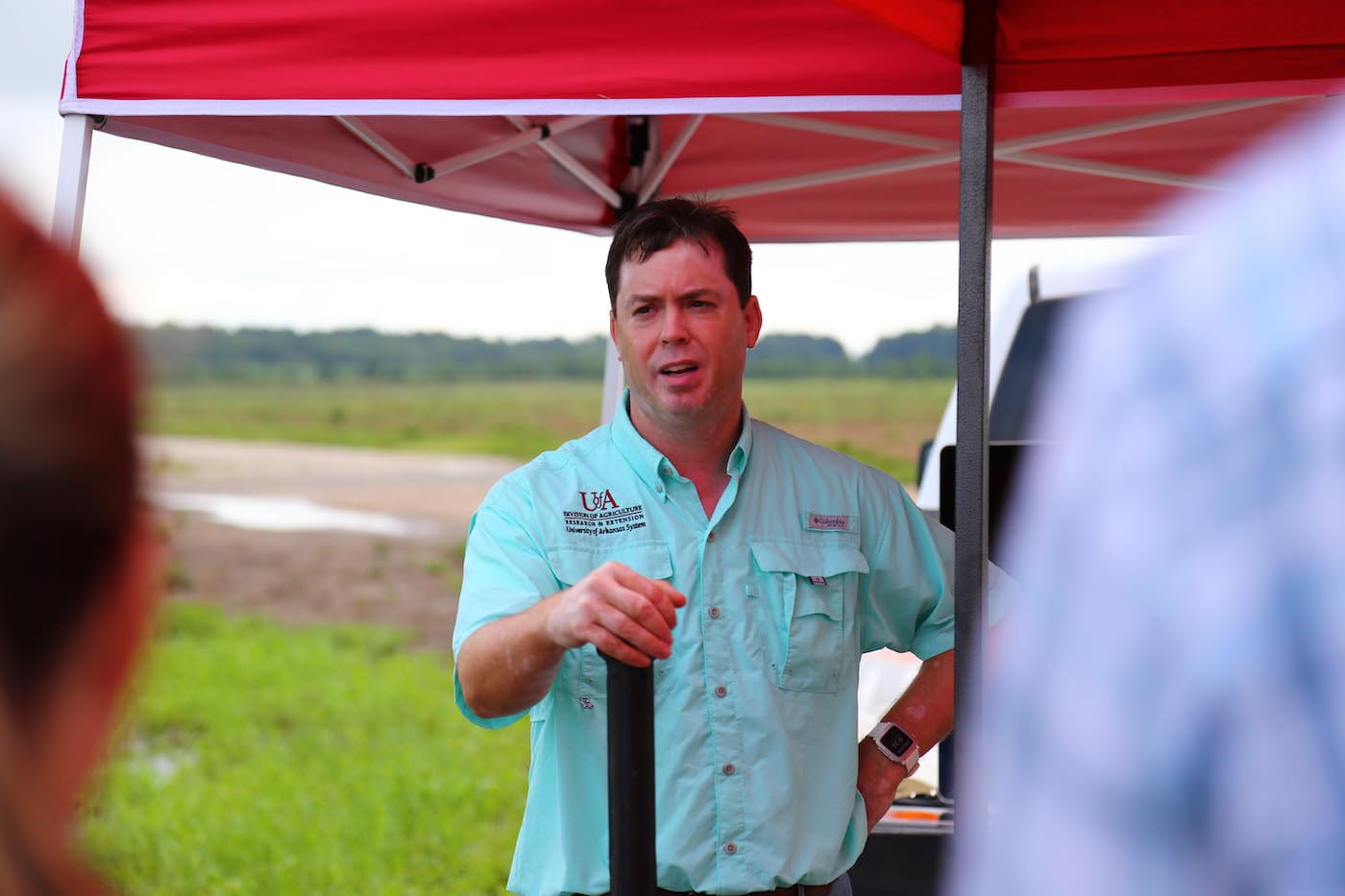Pitless Tailwater Recovery Irrigation a Paradigm Change for Rice


Chris Henry
Assistant Professor and Extension Horticulture Production Specialist – Horticulture
Contact Chris Henry
The Problem
Growing rice in furrow-irrigated fields instead of a flooded field has been made possible with drought-tolerant rice varieties. Irrigation of furrow-irrigated rice is challenging, though, because it requires more frequent irrigation than other row crops, and timing is more critical because rice has a shallower root system.
Conventionally, tailwater recovery is performed using large tailwater pits, ditches, and canals to hold water before being returned to the top of a field from a reservoir using an electric or diesel-powered pump. However, the volume and duration of the tailwater coming off the field is variable and unpredictable. Using a conventional tailwater recovery method also requires significant tailwater catchment zones, which results in an overall reduction in available land for crops and contributes more to wind and water erosion, and sedimentation.
Conventional tailwater recovery systems are also difficult to manage because the volume of water in the tailwater pit is highly variable and often inadequate for an irrigation event. Management then becomes very time consuming as the irrigator must manage the soil moisture with frequent irrigations and supplement tailwater-pit return water with the main irrigation pump.
The Work
Chris Henry, associate professor and water management engineer for the Arkansas Agricultural Experiment Station, has worked on optimizing a recirculation system for irrigation water in row rice since 2013.
Over time, Henry developed a continuous-flow, pitless tailwater system that uses a high-efficiency, 2 to 5-horsepower variable-speed sump pump placed six feet below ground to move water at 500 to 900 gallons per minute. The pump draws about the same amperage as a handheld hair drier, Henry said.
The pump is connected to the top of the field using “lay-flat transfer tubing” which runs through the middle of the field to relay water from the bottom to the top and then feeds into the row-watered poly tubing.
A water-level sensor controls the motor speed. The lower the water level, the slower it runs, he explained. Like other irrigation systems, a computerized hole selection program, such as a Pipe Planner™️, determines poly tubing diameter and hole sizes based on flow, field size and field slope.
Pitless tailwater system management is similar to a flooded field, Henry explained. If the small area of the field at the bottom begins to recede, water can be added, giving the irrigator much more leeway on when to add water to the novel system.
“It provides for much more flexibility when trying to manage water in a FIR (furrow-irrigated rice) field, even when the ponded water at the bottom is nearly gone, the soil in the field is still at saturation,” Henry said.
The Results
Throughout his research since 2013, Henry said he has not used over 19 acre-inches and as little as 12 acre-inches of irrigation water with the pitless tailwater recovery system to produce more rice per acre than the state average of 170 bushels per acre.
In previous research, Henry documented a 16-bushel-per-acre yield difference between FIR and multiple-inlet-rice-irrigated (MIRI) fields. Although a formal study on the pitless system compared to MIRI has not been done, farmers with the pitless system report little to no yield difference in their fields, Henry said.
For example, Stephen Hoskyn won the Arkansas Cooperative Extension Service’s 2021 Most Crop Per Drop contest using the pitless tailwater recovery system, a first win in the contest for row rice. Hoskyn harvested nearly 240 bushels per acre corrected to 12 percent moisture by applying 13.47 acre-inches of irrigation water and 29.56 acre-inches of total water.
Because furrow-irrigation is still a new method, more work is needed to fully understand water use, fertilizer application and weed and pest control using the system.
The Value
In addition to less energy required for the irrigation pump, and less water than a leveed rice field, there is also higher yield potential in row rice with the pitless tailwater recovery system compared to conventional FIR. The continuous flow of irrigation water provides a more consistent ground saturation, which may produce less nitrous oxide than other irrigation methods, Henry said. The water saturation also appears to reduce pigweed pressure, he added.
“The system really opens up a new paradigm in rice production,” Henry said. “Through a decade of research, we have learned the system can result in improved irrigation efficiency, less irrigation water applied, lower global warming potential from reduced methane and nitroxide emissions, feasible no-till, and cover crops can be used.
“Less labor and equipment is needed if beds are re-used between seasons. There is also less pigweed pressure, more flexibility in irrigation timing, and potentially equivalent yields to flooded rice systems. The system provides Arkansas farmers a new option for sustainable rice production.”
Future work includes full automation of the system — which is in the testing phase for 2022 — and evaluating the system in soybeans and corn, Henry added.
The Funding
Funding for Henry’s research has been provided by rice check off funds from the Arkansas Rice Research and Promotion Board. Other support has been provided by the Arkansas Natural Resource Conservation Service, RiceTec, FMC, Bayer, Gowan, ADAMA, Syngenta, OxPipe, Delta Plastics, BASF, UPL, and the University of Arkansas System Division of Agriculture.
About the Researchers
Related Links
- Holistically valuing public investments in agricultural water conservation
- Irrigation Water Management Technologies for Furrow-Irrigated Corn that Decrease Water Use and Improve Yield and On-Farm Profitability
- Relationships among soil factors and greenhouse gas emissions from furrow-irrigated Rice in the mid-southern, USA
- Response of U.S. Rice Cultivars Grown under Non-Flooded Irrigation Management

Chris Henry
Associate Professor and Water Management Engineer, University of Arkansas System Division of Agriculture’s Rice Research and Extension Center in Stuttgart
- B.S. in Biological and Agricultural Engineering – Environmental Emphasis from Kansas State University
- M.S. in Biological and Agricultural Engineering from Kansas State University
- Ph.D. in Agricultural and Biological Engineering from University of Nebraska-Lincoln
Henry’s research focus on irrigation system design, scheduling and efficiency, as well as soil moisture monitoring, vegetative treatment systems for open lot runoff, ambient odor assessment and modeling, grain handling, and animal manure management. He leads a research and extension water management program for the University of Arkansas and maintains a mobile app for developing rice irrigation plans using lay-flat pipe. The app, Rice Irrigation, is available on both the Google Play and the Apple’s App stores.
Related Links
- Holistically valuing public investments in agricultural water conservation
- Irrigation Water Management Technologies for Furrow-Irrigated Corn that Decrease Water Use and Improve Yield and On-Farm Profitability
- Relationships among soil factors and greenhouse gas emissions from furrow-irrigated Rice in the mid-southern, USA
- Response of U.S. Rice Cultivars Grown under Non-Flooded Irrigation Management
